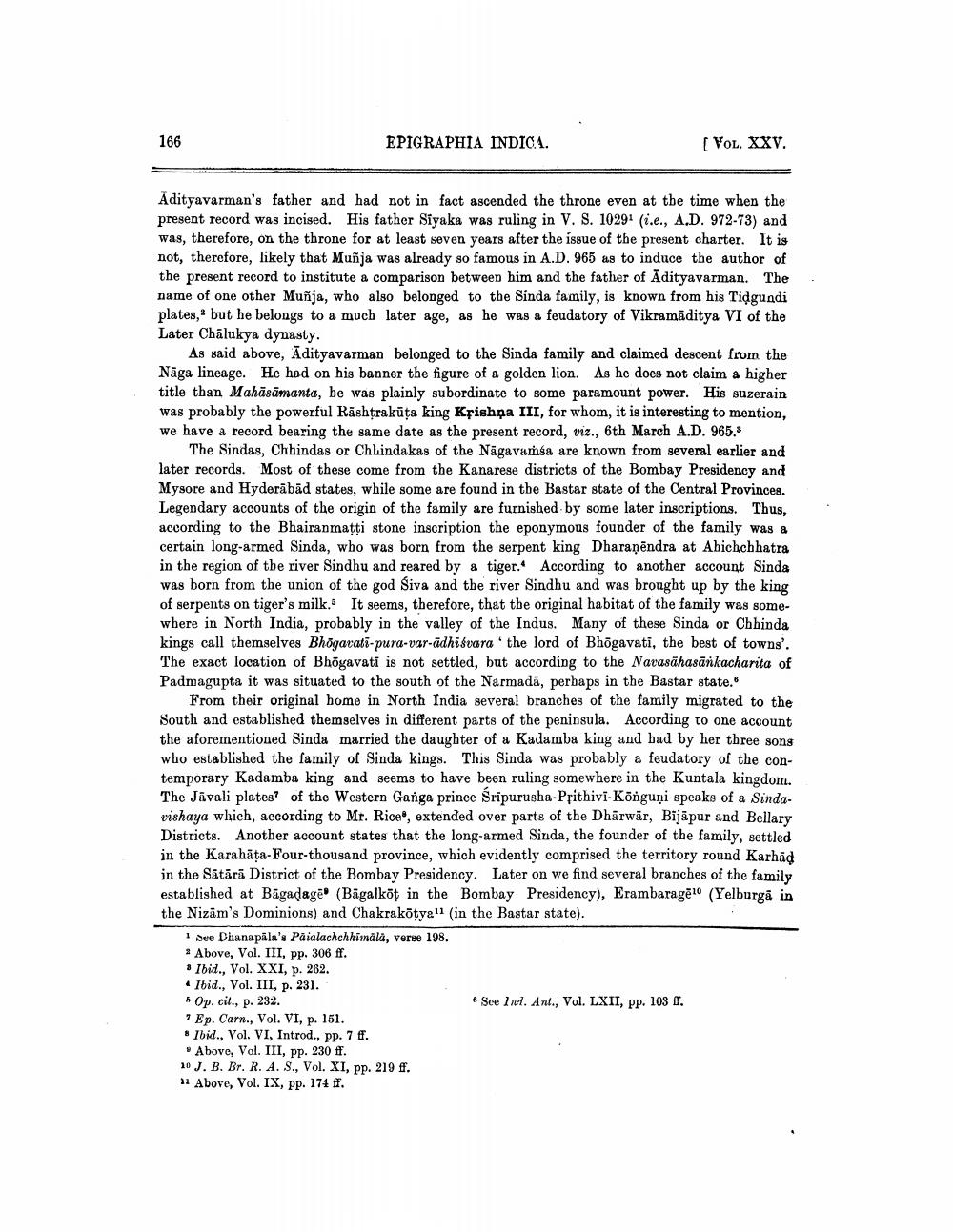________________
166
EPIGRAPHIA INDICA.
Adityavarman's father and had not in fact ascended the throne even at the time when the present record was incised. His father Siyaka was ruling in V. S. 10291 (i.e., A.D. 972-73) and was, therefore, on the throne for at least seven years after the issue of the present charter. It is not, therefore, likely that Muñja was already so famous in A.D. 965 as to induce the author of the present record to institute a comparison between him and the father of Adityavarman. The name of one other Muñja, who also belonged to the Sinda family, is known from his Tiḍgundi plates, but he belongs to a much later age, as he was a feudatory of Vikramaditya VI of the Later Chalukya dynasty.
As said above, Adityavarman belonged to the Sinda family and claimed descent from the Nāga lineage. He had on his banner the figure of a golden lion. As he does not claim a higher title than Mahāsāmanta, be was plainly subordinate to some paramount power. His suzerain was probably the powerful Rashtrakuta king Krishna III, for whom, it is interesting to mention, we have a record bearing the same date as the present record, viz., 6th March A.D. 965.3
The Sindas, Chhindas or Chhindakas of the Nagavamsa are known from several earlier and later records. Most of these come from the Kanarese districts of the Bombay Presidency and Mysore and Hyderabad states, while some are found in the Bastar state of the Central Provinces. Legendary accounts of the origin of the family are furnished by some later inscriptions. Thus, according to the Bhairanmațți stone inscription the eponymous founder of the family was a certain long-armed Sinda, who was born from the serpent king Dharanendra at Ahichchhatra in the region of the river Sindhu and reared by a tiger. According to another account Sinda was born from the union of the god Śiva and the river Sindhu and was brought up by the king of serpents on tiger's milk. It seems, therefore, that the original habitat of the family was somewhere in North India, probably in the valley of the Indus. Many of these Sinda or Chhinda kings call themselves Bhogavati-pura-var-adhiśvara the lord of Bhōgavati, the best of towns'. The exact location of Bhōgavati is not settled, but according to the Navasahasānkacharita of Padmagupta it was situated to the south of the Narmada, perhaps in the Bastar state."
From their original home in North India several branches of the family migrated to the South and established themselves in different parts of the peninsula. According to one account the aforementioned Sinda married the daughter of a Kadamba king and had by her three sons who established the family of Sinda kings. This Sinda was probably a feudatory of the contemporary Kadamba king and seems to have been ruling somewhere in the Kuntala kingdom. The Javali plates of the Western Ganga prince Śrīpurusha-Prithivi-Kōnguni speaks of a Sindavishaya which, according to Mr. Rice, extended over parts of the Dharwar, Bijapur and Bellary Districts. Another account states that the long-armed Sinda, the founder of the family, settled in the Karahaṭa-Four-thousand province, which evidently comprised the territory round Karhad in the Satara District of the Bombay Presidency. Later on we find several branches of the family established at Bagaḍage (Bagalkōṭ in the Bombay Presidency), Erambarage1 (Yelburga in the Nizam's Dominions) and Chakrakōtya" (in the Bastar state).
1 Dee Chanapala's Paialachchhimälä, verse 198.
* Above, Vol. III, pp. 306 ff.
Ibid., Vol. XXI, p. 262.
Ibid., Vol. III, p. 231.
5 Op. cit., P. 232.
[VOL. XXV.
7 Ep. Carn., Vol. VI, p. 151.
Ibid., Vol. VI, Introd., pp. 7 ff.
Above, Vol. III, pp. 230 ff.
10 J. B. Br. R. A. S., Vol. XI, pp. 219 ff.
11 Above, Vol. IX, pp. 174 ff.
See Ind. Ant., Vol. LXII, pp. 103 ff.




